Mastering the Art of Primitive Bushcraft Skills for Self-Sufficiency

Mastering primitive bushcraft skills is essential for achieving self-sufficiency in the wild. These skills, rooted in ancient survival techniques, enable you to live sustainably using natural resources and minimal equipment. Whether you’re an outdoor enthusiast or preparing for emergencies, understanding and practicing these fundamental skills can greatly enhance your ability to thrive in nature. This article explores key primitive bushcraft skills and provides guidance on how to develop them.
The Importance of Primitive Bushcraft Skills
Primitive bushcraft skills are foundational for self-sufficiency and survival in the wild. These skills involve using natural materials and traditional techniques to build shelter, start fires, find food, and navigate the environment. Mastering these skills allows you to become more self-reliant and resilient in various outdoor scenarios. For a deeper dive into essential bushcraft skills, exploring comprehensive resources can provide further insights and practical advice.
Key Primitive Bushcraft Skills
1. Fire-Making Techniques
One of the most crucial bushcraft skills is the ability to start and maintain a fire. Primitive methods include:
- Flint and Steel: Striking steel against flint to create sparks that ignite tinder.
- Bow Drill: Using friction between a spindle and a hearth board to generate heat and create an ember.
- Fire Plough: Rubbing a wooden stick along a groove in another piece of wood to produce friction and heat.
Each method requires practice and understanding of the materials involved, but mastering them ensures you can start a fire under various conditions.
2. Shelter Building
Building a shelter is essential for protection against the elements. Common primitive shelters include:
- Debris Hut: Constructed using a framework of branches covered with a thick layer of leaves and other natural materials.
- Lean-To: A simple shelter made by leaning branches against a support and covering them with foliage.
- Tarp Shelter: Using a tarp or similar material to create a temporary shelter from rain and wind.
Understanding how to build these shelters helps you stay warm, dry, and safe in different environments.
3. Foraging and Identifying Edible Plants
Foraging for edible plants is a valuable skill for supplementing your diet in the wild. Key practices include:
- Plant Identification: Learning to recognize edible plants and avoid toxic ones.
- Harvesting Techniques: Knowing the best times and methods for gathering plants to ensure sustainability and safety.
Effective foraging can provide essential nutrients and expand your food sources in a survival situation.
4. Primitive Tool Making
Crafting tools from natural materials is a fundamental skill in bushcraft. Techniques include:
- Stone Tools: Knapping stones to create cutting implements and other tools.
- Woodworking: Carving and shaping wood to make tools, utensils, and other items.
Creating your own tools allows you to use the resources available in your environment and enhances your self-sufficiency.
Developing Your Bushcraft Skills
To master these primitive skills, consider the following:
- Practice Regularly: Frequent practice helps improve your proficiency and confidence.
- Seek Training: Attend workshops or courses to learn from experienced instructors.
- Use Resources: Consult books, online guides, and communities focused on bushcraft and survival skills.
Conclusion
Mastering primitive bushcraft skills is key to achieving self-sufficiency and resilience in the wild. By learning techniques such as fire-making, shelter building, foraging, and tool making, you can enhance your ability to live sustainably and handle various survival scenarios. For further exploration of essential bushcraft skills, delve into additional resources and training opportunities to expand your knowledge and capabilities.







